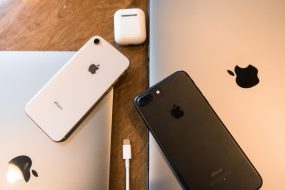“To most Indians, the smartphone is their first camera, first TV, first video device, first Walkman, and first MP3 player. It may even be their first alarm clock and calculator,” according to Ravi Agrawal, managing editor of Foreign Policy and former CNN New Delhi bureau chief. That is the dramatic change this small device is bringing to hundreds of millions of Indians, as extremely low-cost smartphones and data plans increasingly become available.
Technology in India has traditionally been only available to the rich, to English speakers, and to city dwellers, Agrawal noted. Indeed, the internet was “long a source of great divides in India,” he said, but the smartphone could start to close the gap.
To be sure, widespread use of smartphones has obvious benefits: improvements in education, greater access to information, higher productivity, more efficiency. But there is a dark side. Use of the device is spreading like wildfire through a population that Agrawal believes hasn’t been adequately prepared to handle mobile technology wisely and safely. He discussed the issue recently in a talk at the University of Pennsylvania’s Perry World House, based on his new book India Connected: How the Smartphone is Transforming the World’s Largest Democracy.
The smartphone has tremendously accelerated India’s access to the internet. In 2000, only about 2% or 3% of the country’s population owned personal computers and landline telephones, so they were the only ones with access. (In the U.S. at the same time, 50% of people were online.) Ten years later, 100 million Indians were online as many bought PCs or visited cyber cafes. But there were still millions without access. Today, some 465 million Indians are online, out of a population of 1.3 billion, and the number is increasing at the breathtaking rate of three people per second, Agrawal said.
“Most Indians can’t afford PCs; most Indians will never, ever own a PC,” notes Agrawal. Many will never have landline telephones either. But with the smartphone, neither is necessary.
“To most Indians, the smartphone is their first camera, first TV, first video device, first Walkman, and first MP3 player. It may even be their first alarm clock and calculator.” –Ravi Agrawal
Although most Indians cannot afford to buy iPhones (they cost about $1,200 in that country, the lion’s share of an average citizen’s salary), companies such as Xiaomi, Samsung, Micromax, and Reliance Jio are offering them phones they can afford. In some cases, noted Agrawal, a smartphone can be leased for less than $23. “That’s how cheap it is now to try and get online.”
In addition to breaking the financial barrier, smartphones have broken the language barrier. Most of the population doesn’t speak English, and English used to be a necessity for internet use. But “smartphones have changed all of that,” observed Agrawal. Now if you speak Hindi, Bengali, or one of India’s many other tongues, multilingual software enables you to type, search, and read online.
Even illiterate individuals — of whom there are nearly 300 million in India — can learn to use the device. With the Google Assistant, they can say in their own language, for example, “‘Show me the Taj Mahal,’ and up pops a video showing them this great wonder that they’ve all heard of but never seen,” notes Agrawal. So in some ways the smartphone is a great equalizer.
Fake News on the Phone
Yet with all the apparent benefits, “there is so much that can go wrong,” said Agrawal. One problem is the proliferation of “fake news,” which he noted has sparked religiously-motivated lynchings and other violence.
India has also experienced more internet shutdowns than any other nation — Syria and Iraq follow — in which the government temporarily pulls the plug in the name of halting rumors that spark unrest. There were over 100 shutdowns in 2018 alone, according to Forbes, and the frequency appears to be increasing. These have a negative effect on the economy as well.
There’s also been an explosion in pornography, Agrawal notes. “The head of one of India’s biggest wireless companies told me that 70% of his company’s bandwidth is porn, believe it or not.”
According to Agrawal, a young boy growing up in rural India has a very different life than someone growing up in the West. “He’s not really sensitized to the female body … he’s never even seen a woman’s legs.” He is segregated from girls in school and in college, and may have unhealthy notions of the opposite sex, and sex in general. “And then if porn — and oftentimes violent porn — is this person’s first entry point to romance and sexuality, that’s immensely damaging in ways that I don’t think we fully have come to comprehend as a society,” said Agrawal.
Agrawal was asked about a possible link between the large amount of pornography and the problem of sexual violence against women in India (what BBC News recently called India’s “rape crisis.”) He said that although as a journalist he believed in freedom of information — and that he approached the question of internet porn without passing moral judgment — he believed it was “a real problem … a contributing factor that we have to keep in mind.”
One problem is the proliferation of “fake news,” which has sparked religiously-motivated lynching and other violence.
Another internet-related problem is a condition that Agrawal callled nomophobia, or ‘no-mobile-phobia,’ the fear of being separated from your phone or losing battery power, which is on the rise in India. While some may find this hard to take seriously, it’s not a laughing matter, he said. “It’s a growing concern because it has led to many young Indians feeling a real sense of anxiety and depression when they’re not near their phone.” Agrawal linked the phenomenon to the sudden proliferation of smartphones in a population with little or no technology experience.
He drew an interesting comparison between India’s smartphone revolution and the profound effects of the automobile on 20th-century America. The mass availability of the car led to the interstate highway system, which in turn led to the rise of suburban communities and the concept of commuting to work. Cars also helped create so-called bits of “Americana” — diners, gas stations, drive-ins — not to mention the cultural and imaginative zeitgeist. “Every Hollywood movie featured the car: the race, the chase … the first kiss was always in the car.” Agrawal said the car was every American’s “first private property … it was freedom, the American dream.”
The smartphone might be functioning in a similar way for India, a young country in which the average age is 27. “Can this be their mobility? Can it be their dream of a better life, a better job, to improve their education?” Another parallel Agrawal drew was that in India, one’s smartphone and choice of phone cover express something about the owner’s age and status, the way Americans may judge each other based on their cars’ make and model.
But again, there’s a need for people to be educated about the devices they’re using. “The car can be a weapon of mass destruction,” said Agrawal. “There’s a reason why governments and the private sector invest so much money in campaigns to tell you not to drink and drive, and … to wear a seat belt.” Similarly, Indians need guidance on using smartphones safely and responsibly, “and learn how not to be susceptible to fearmongering when we’re online.”
In India, 70% of Uber rides are paid for in cash. “Why? Indians don’t trust credit cards. They just don’t believe in that system, not yet.”
Cash in E-commerce
Agrawal described differences between how smartphones are used in India and in Westernized nations. For one thing, India is a cash-based society, and that preference has carried over into its internet commerce. In India, 70% of Uber rides are paid for in cash. “Why? Indians don’t trust credit cards. They just don’t believe in that system, not yet.” Similarly, Flipkart, Amazon’s main competitor in India, instituted a system in which the recipient pays cash for their item upon delivery.
He termed India a “low-trust society,” citing an additional example of Indians carrying dual SIM cards in their smartphones, another thing that most Westerners don’t have. “Let’s say you have Airtel and Vodafone, you’re sort of hedging your bets because Airtel might work one day, Vodafone might work the other day, so you want to make sure you’ve got both options.”
Moreover, Indians tend to pay for data as they go, rather than sign a monthly contract. “They’ll put down 200 rupees for data and wait until they use it [up], and then put down another 200 rupees.” This arrangement, noted Agrawal, suits both the customer and the company, because the lack of trust cuts both ways. Customers want to ensure they can switch carriers at any time, and companies want to ensure they don’t get stuck with exorbitant monthly usage bills from customers with insufficient funds.
While Agrawal stood by his belief that the smartphone is hugely transformative for India, and is perhaps the biggest change agent of all, trust will take time to develop. Yet it doesn’t have to be an insurmountable hurdle. Trust can be “almost like inertia, you sort of push and push and push, and then there’s a moment where suddenly society trusts more.”
Overall, he believes that the smartphone is essentially a catalyst, along with other advances in India such as rapid urbanization, the empowerment of women, vast infrastructure spending and rising income levels. “It’s going to make things speed up,” Agrawal said. “It’s going to give everyone a way to participate in all this change.”










